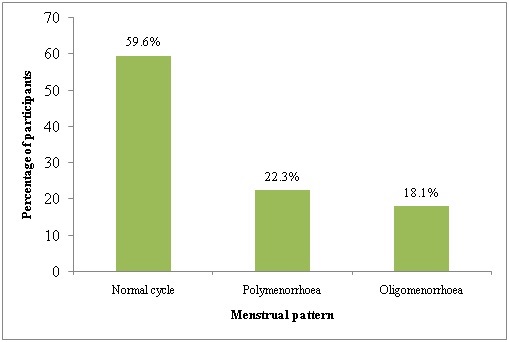Prevalence and pattern of menstrual disorders among school going adolescents in northern district of Kerala
Abstract
Background: Adolescents face a range of health challenges, numerous information and guidance regarding adolescent health remaining ignored due to constraints at different levels of health system.One of the main problems among adolescent girls are irregular menstruation, excessive bleeding and dysmenorrhoea. Menstrual irregularities during adolescent period have association with reproductive morbidities in adulthood. Targeting this age group with awareness and early correction of matters and misconceptions related to adolescent sexual reproductive health issues would enable us to yield a healthy society and empowered youth.
Objective:To study the prevalence and pattern of menstrual disorders and its associated factors among IX to XII class adolescent girls in Kannur district.
Methods:Cross-sectional study among school going adolescent Girls from class IX to XII in Kannur District
Results:Among the 1722 study participants, 48.8% had menstrual disorders, in which dysmenorrhoea is the most common menstrual disorder reported 71.5%. The risk factors like rural residence, lower socio-economic status, mixed diet, non-consumption of egg, not physically active both during routine life and also during menstruation, increased BMI showed a significant association with menstrual disorder among the study participants.
Conclusion:Use of services by adolescents is limited may be due to lack of adequate privacy and confidentiality and judgemental attitudes of service providers, who often lack counselling skills. Therefore, effective services like assurance of confidentiality, psychological support, counselling is necessary.
Downloads
References
2. A Strategic Approach to Reporoductive, Maternal, Newborn, Child and Adolescent Health (RMNCH+A) in India. Ministry of Health & Family Welfare Government of India,; 2013.
3. Dambhare DG, Wagh SV, Dudhe JY. Age at menarche and menstrual cycle pattern among school adolescent girls in Central India. Glob J Health Sci. 2012 Jan 1;4(1):105-11. doi: 10.5539/gjhs.v4n1p105.
4. Omidvar S, Begum K. Menstrual pattern among unmarried women from south India. J Nat Sci Biol Med. 2011 Jul;2(2):174-9. doi: 10.4103/0976-9668.92329.
5. Singh A, Kiran D, Singh H, Nel B, Singh P, Tiwari P. Prevalence and severity of dysmenorrhea: a problem related to menstruation, among first and second year female medical students. Indian J Physiol Pharmacol. 2008 Oct-Dec;52(4):389-97.
6. Andersch B, Milsom I. An epidemiologic study of young women with dysmenorrhea. Am J Obstet Gynecol [Internet]. 1982 Nov 15 [cited 2014 Nov 4];144(6):655–60. Available from: http://www.ncbi.nlm.nih.gov/pubmed/7137249
7. Santina T, Wehbe NF. Ziade. Exploring dysmenorrhoea and menstrual experiences among Lebanese female adolescents. Eastern Meditarranean journal.2012; 18(8):857-863.
8. Anandha Lakshmi et al. Prevalence of Premenstrual Syndrome and Dysmenorrhoea among Female Medical Students and its Association with College Absenteeism. Int J Biol Med Res. 2011; 2(4): 1011 -1016
9. Nair MK, Chacko DS, Ranjith Darwin M, Padma K, George B, P S R. Menstrual disorders and menstrual hygiene practices in higher secondary school girls. Indian J Pediatr. 2012 Jan;79 Suppl 1:S74-8. doi: 10.1007/s12098-011-0431-z. Epub 2011 May 28.
10. Kumar D, Goel NK, Puri S, Pathak R, Sarpal SS, Gupta S et al. Menstrual Pattern among Unmarried Women from Northern India. J Clin Diagn Res [Internet]. 2013 Sep [cited 2014 Nov 7];7(9):1926–9. Available from: http://www.pubmedcentral.nih.gov/articlerender.fcgi?artid=3809638&tool=pmcentrez&rendertype=abstract
11. World Health Organisation. Global Recommendations On Physical Activity For Health. 2010. Available form: http://apps.who.int/iris/bitstream/10665/44399/1/9789241599979_eng.pdf
12. Park K. Textbook of Preventive and Social Medicine, 23rd Edition; Bhanot Publications, p- 620-635
13. Nag U, Kodali M. Meditation And Yoga As Alternative Therapy For Primary Dysmenorrhea . IJMPS. (2013), [cited June 09, 2016]; 3(7): 39-44.
14. Balbi C, Musone R, Menditto A, Di Prisco L, Cassese E, D'Ajello M, Ambrosio D, Cardone1 A. Influence of menstrual factors and dietary habits on menstrual pain in adolescence age. Eur J Obstet Gynecol Reprod Biol. 2000 Aug;91(2):143-8.
15. Douchi T, Kuwahata R, Yamamoto S, Oki T, Yamasaki H, Nagata Y. Relationship of upper body obesity to menstrual disorders. Acta Obstet Gynecol Scand. 2002 Feb;81(2):147-50.
16. Bernstein L, Henderson BE, Hanisch R, Sullivan-Halley J, Ross RK. Physical exercise and reduced risk of breast cancer in young women. J Natl Cancer Inst. 1994 Sep 21;86(18):1403-8.

Copyright (c) 2016 Author (s). Published by Siddharth Health Research and Social Welfare Society

This work is licensed under a Creative Commons Attribution 4.0 International License.


 OAI - Open Archives Initiative
OAI - Open Archives Initiative


